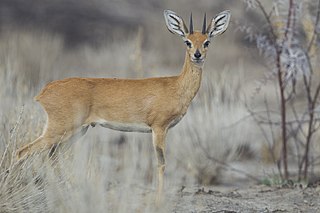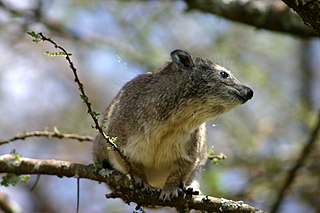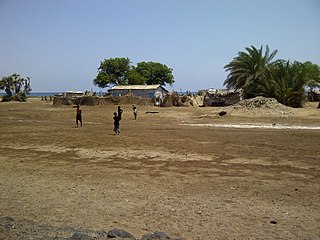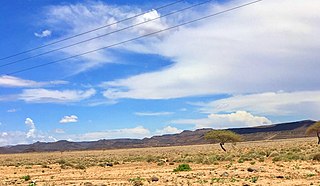
The rock hyrax, also called dassie, Cape hyrax, rock rabbit, and coney, is a medium-sized terrestrial mammal native to Africa and the Middle East. Commonly referred to in South Africa as the dassie, it is one of the five living species of the order Hyracoidea, and the only one in the genus Procavia. Rock hyraxes weigh 4–5 kg (8.8–11.0 lb) and have short ears.

The dorcas gazelle, also known as the ariel gazelle, is a small and common gazelle. The dorcas gazelle stands about 55–65 cm at the shoulder, with a head and body length of 90–110 cm and a weight of 15–20 kg. The numerous subspecies survive on vegetation in grassland, steppe, wadis, mountain desert and in semidesert climates of Africa and Arabia. About 35,000–40,000 exist in the wild.

The mountain gazelle, also called the true gazelle or the Palestine mountain gazelle, is a species of gazelle that is widely but unevenly distributed.

The rhim gazelle or rhim, also known as the slender-horned gazelle, African sand gazelle or Loder's gazelle, is a pale-coated gazelle with long slender horns and well adapted to desert life. It is considered an endangered species because fewer than 2500 are left in the wild. They are found in Algeria, Egypt, Tunisia and Libya, and possibly Chad, Mali, Niger, and Sudan.

The dama gazelle, also known as the addra gazelle or mhorr gazelle, is a species of gazelle. It lives in Africa, in the Sahara desert and the Sahel. A critically endangered species, it has disappeared from most of its former range due to overhunting and habitat loss, and natural populations only remain in Chad, Mali, and Niger. Its habitat includes grassland, shrubland, semi-deserts, open savanna and mountain plateaus. Its diet includes shrubs, herbs, grasses, leaves, shoots, and fruit.

Paleolimnology is a scientific sub-discipline closely related to both limnology and paleoecology. Paleolimnological studies focus on reconstructing the past environments of inland waters using the geologic record, especially with regard to events such as climatic change, eutrophication, acidification, and internal ontogenic processes.

The Arabian gazelle(Gazella arabica) is a species of gazelle from the Arabian Peninsula. There are approximately 5,000 – 7,000 mature individuals in the wild.

The steenbok is a common small antelope of southern and eastern Africa. It is sometimes known as the steinbuck or steinbok.

The Yotvata Hai-Bar Nature Reserve is a 3,000-acre (12 km2) breeding and reacclimation center administered by the Israel Nature Reserves & National Parks Authority, situated in the Southern Arava near Yotvata.

Grant's gazelle is a relatively large species of gazelle antelope, distributed from northern Tanzania to South Sudan and Ethiopia, and from the Kenyan coast to Lake Victoria. Its Swahili name is swala granti. It was named for a 19th-century British explorer, James Grant.

The southern tree hyrax, also known as the southern tree dassie, is a species of mammal in the family Procaviidae. The southern tree hyrax is mainly found in the south central eastern side of Africa.

The tree hyrax or tree dassie is a small nocturnal mammal native to Africa. Distantly related to elephants and sea cows, it comprises the four species in the genus Dendrohyrax, one of only three genera in the family Procaviidae, which is the only living family within the order Hyracoidea.

Hyraceum is the petrified and rock-like excrement composed of both urine and feces of the rock hyrax and closely related species.

The Eritrean coastal desert ecoregion is a harsh sand and gravel strip along the southern part of the coast of Eritrea and the Red Sea coast of Djibouti. This coast is of ecological importance as a channel for the mass migration of birds of prey.

The Grand Bara, Bara Wein or Bada Wein, is a desert in southern Djibouti. It consists of large areas of sand flats, with sparse, semi-desert and desert grasses and scrub vegetation. A road built in 1981 passes through the area, connecting the capital Djibouti City with the south. Prior to the arrival of the French, the extremely arid interior was inhabited primarily by the Issa Somali. Runners make their way across the Grand Bara Desert during the Annual Grand Bara 15K race.
Animal latrines are places where wildlife animals habitually defecate and urinate. Many kinds of animals are highly specific in this respect and have stereotyped routines, including approach and departure. Many of them have communal, i.e., shared, latrines.
Elands Bay Cave is located near the mouth of the Verlorenvlei estuary on the Atlantic coast of South Africa's Western Cape Province. The climate has continuously become drier since the habitation of hunter-gatherers in the Later Pleistocene. The archaeological remains recovered from previous excavations at Elands Bay Cave have been studied to help answer questions regarding the relationship of people and their landscape, the role of climate change that could have determined or influenced subsistence changes, and the impact of pastoralism and agriculture on hunter-gatherer communities.
Michael Edward MeadowsFAAS FRSSAf is a British-South African Emeritus Professor of physical geography at the Department of Environmental and Geographical Sciences, University of Cape Town.

A rock hyrax midden is a stratified accumulation of fecal pellets and a brown amber-like a urinary product known as hyraceum excreted by the rock hyrax and closely related species.
Gruta del Indio is a rock shelter located in Rincón del Atuel, Southern Mendoza, Argentina. The site is located 28 km south of the town of San Rafael at around 660m above sea level. Significant excavations suggest the coexistence of humans and mega-fauna, possibly contributing to existing theories of humans acting as major predators were large contributors to the extinction of such creatures.






















